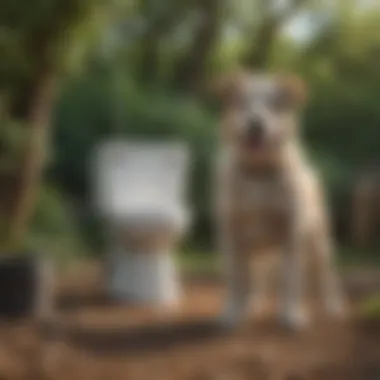Expert Guide: Training an Older Dog to Poop Outside Effectively


Pet Care Essentials
Behavior & Training
Understanding your pet's body language is key to effectively communicating with your older dog during the toileting training process. Basic training techniques can be adapted to suit the needs of older dogs, emphasizing patience and positive reinforcement. Behavior concerns and solutions specific to older dogs should be addressed with care, along with socialization tips to help your senior pet adapt to outdoor toileting habits effectively.
Pet Home Environment
Creating a pet-friendly space is essential for encouraging outdoor toileting habits in old dogs. Safety measures and hazards to avoid should be carefully considered to prevent accidents or discomfort for your senior canine companion. Choosing the right toys and accessories can also aid in making the outdoor toileting area more enticing for your older dog. Setting up a comfortable resting area outdoors can further enhance your pet's overall well-being during the training process.
Pet Health Issues
Recognizing signs of illness in older dogs is crucial to their overall health and well-being. Implementing preventative care measures, such as regular vet check-ups and vaccinations, can help mitigate health risks. Familiarizing yourself with common ailments that affect older dogs and their respective treatments is essential for proactive care. Additionally, having an emergency preparedness plan in place ensures swift action in case of any health emergencies.
Understanding Your Older Dog's Behavior
In the realm of training an older dog to poop outside, a crucial foundation lies in comprehending your furry companion's behavior. Understanding the intricacies of an older dog's behavior allows pet owners to adapt training methods to suit their pet's specific needs effectively. By delving into your canine's behavioral patterns, you can identify physical limitations, quirks, and preferences that may influence their toileting habits. This profound understanding forms the cornerstone for a successful training program that caters to your older dog's unique requirements and ensures a smoother transition to outdoor elimination practices.
Recognizing Physical Limitations
When addressing the physical limitations of an older dog in the context of outdoor potty training, two primary aspects come to the fore: Mobility Issues and Bladder Control Challenges.
Mobility Issues
Mobility issues encompass a range of conditions that can hinder an older dog's ability to toilet outside efficiently. These may include arthritis, muscle stiffness, or joint pain, impacting their mobility and comfort during outdoor elimination. Understanding and accommodating these mobility challenges are fundamental in tailoring a training regimen that considers your dog's physical constraints and ensures a comfortable toileting experience. By recognizing and addressing mobility issues, pet owners can optimize the training process to foster successful outdoor elimination habits.
Bladder Control Challenges
A paramount consideration in training older dogs to poop outside revolves around managing bladder control challenges. These challenges arise due to age-related factors such as weakened bladder muscles or diminished control over urinary functions. By addressing bladder control challenges attentively, pet owners can implement strategies to support their dog's bladder health and regulate bathroom habits effectively. Recognizing the unique nature of bladder control challenges enables a tailored approach to outdoor toileting training, ensuring a conducive environment for your older dog's physical well-being.


Establishing Routine and Consistency
Integral to proficient outdoor potty training for older dogs is the establishment of a structured routine and consistent approach.
Scheduled Feeding Times
Scheduled feeding times play a pivotal role in regulating your dog's digestive system and optimizing toileting behaviors. By adhering to a consistent feeding schedule, pet owners can predict when their dog will likely need to eliminate waste, facilitating timely outdoor toileting opportunities. Scheduled feeding times not only promote digestive health but also aid in creating a predictable routine that reinforces proper elimination habits, fostering a positive outdoor toileting experience for older dogs.
Regular Bathroom Breaks
In conjunction with feeding schedules, regular bathroom breaks are essential in maintaining a consistent outdoor toileting routine for older dogs. These breaks provide opportunities for your dog to relieve themselves in appropriate outdoor locations, reinforcing positive elimination behaviors. By incorporating regular bathroom breaks into the daily schedule, pet owners can prevent accidents indoors and instill good toileting habits in older pets. Consistency in offering bathroom breaks promotes bladder health and ensures that your furry companion experiences successful outdoor elimination sessions.
Identifying Behavioral Cues
Crucial to training an older dog to poop outside is the ability to recognize behavioral cues that signal their need to eliminate.
Sniffing and Circling
The behavioral cues of sniffing and circling are indicative signs that your dog is preparing to eliminate waste. By observing these behaviors, pet owners can anticipate their dog's toileting needs and promptly guide them to an appropriate outdoor location. Understanding the significance of sniffing and circling enables pet owners to proactively respond to their dog's signals, facilitating successful outdoor elimination training. By acknowledging and acting upon these behavioral cues, pet owners can reinforce positive toileting behaviors and create a seamless transition to outdoor elimination practices.
Restlessness
Restlessness in older dogs can often signal an imminent need for toileting. This agitation or pacing behavior indicates your dog's discomfort with a full bladder or bowel, prompting the necessity for outdoor elimination. Recognizing restlessness as a behavioral cue for toileting allows pet owners to intervene promptly and guide their dog to the designated outdoor area. By addressing restlessness effectively, pet owners can preempt accidents indoors and establish a pattern of successful outdoor elimination for their older canine companions.
Creating a Positive Outdoor Environment
Choosing a Designated Toilet Area
When selecting a designated toilet area for your senior canine companion, both Accessibility and Comfort are essential factors to consider. ** Accessibility refers to the ease of reaching the area for your dog to relieve themselves. This can include factors such as proximity to the living space, absence of obstacles, and suitable walking conditions for older dogs with potential mobility challenges. Ensuring Accessibility simplifies the toileting process for your pet and reduces the likelihood of accidents indoors. On the other hand, Comfort centers around creating a pleasant environment that encourages your dog to use the designated area consistently. Focusing on soft, non-abrasive surfaces, adequate lighting, and sufficient space can enhance your dog's comfort and willingness to follow the intended toileting routine. By combining Accessibility and Comfort, pet owners can effectively establish a functional and inviting toilet area that meets their dog's needs and facilitates successful training outcomes.
Removing Indoor Elimination Traces


Effective cleaning techniques are paramount in maintaining a hygienic indoor environment while training your old dog to poop outside. Through thorough cleaning practices, pet owners can eliminate traces of indoor elimination, reducing the chances of repeat accidents in the same spots. Using appropriate cleaning products that neutralize odors and stains is essential to deter dogs from revisiting previously soiled areas. Effective cleaning techniques not only support outdoor toileting habits but also promote a clean and odor-free living space for both dogs and owners. Additionally, the use of neutralizing agents can aid in eradicating residual scents that may attract dogs to inappropriate elimination sites. By addressing indoor traces promptly and effectively, pet owners can reinforce the desired behavior of outdoor elimination, creating a positive environment for successful training sessions.
Utilizing Encouragement and Rewards
Encouraging your older dog to poop outside involves utilizing positive reinforcement strategies such as verbal praise and treats. Misstep Verbal praise offers immediate feedback to your dog and reinforces their good behavior during toileting. By using a cheerful and encouraging tone, pet owners can communicate approval to their pets, encouraging them to repeat the desired action in the designated outdoor area. In contrast, treats serve as tangible rewards that motivate dogs to comply with the outdoor toilet routine. Selecting treats that are both appealing and appropriate for your pet ensures a positive association with outdoor elimination. By combining verbal praise and treats judiciously, pet owners can establish a rewarding system that encourages consistent outdoor toileting behavior in their old dogs.
Implementing Training Techniques
Leash Training for Guided Toileting
Gentle Guidance
Leash training for guided toileting involves gently directing your older dog to designated potty areas when outdoors. This method emphasizes the use of subtle cues and gentle movements to encourage your dog to eliminate waste in a specific location. Gentle guidance is beneficial because it reinforces positive behavior without causing stress or confusion for your pet. By gently guiding your dog while on a leash, you can establish a routine and provide clear direction, promoting outdoor toileting success. The unique feature of gentle guidance lies in its ability to create a positive association between outdoor toileting and the gentle guidance provided, leading to consistent and reliable outdoor potty habits.
Repetition
Repetition plays a critical role in leash training for guided toileting as it helps reinforce desired behaviors and establish consistent routines. By repeating the process of leash training regularly, you can help your older dog understand the expectations for outdoor toileting. Consistent repetition reinforces the connection between the designated potty area, the leash-guided experience, and the act of eliminating waste outdoors. While repetition is essential for training success, it is important to balance repetition with patience and positive reinforcement to prevent your dog from becoming overwhelmed or bored. The advantage of using repetition in this article is its effectiveness in solidifying outdoor toileting habits through consistent practice and reinforcement.
Positive Reinforcement Strategies
Clicker Training
Clicker training is a valuable positive reinforcement strategy that involves using a clicker to signal desired behavior and promptly rewarding your dog for the correct response. This method is popular because it provides instant feedback and creates a clear association between the desired action and the reward it receives. Clicker training is beneficial for older dogs as it allows for precise communication and timely reinforcement of outdoor toileting behavior. The unique feature of clicker training lies in its ability to strengthen the bond between the owner and the dog while facilitating quick learning and behavior modification.
Consistent Verbal Cues
Consistent verbal cues are essential for reinforcing outdoor toileting behavior and maintaining communication with your older dog during training sessions. By using consistent verbal cues such as specific words or phrases associated with toileting, you can help your dog understand what is expected of it when outdoors. Consistent verbal cues provide clarity and structure to the training process, enabling your dog to associate the cues with the desired behavior. The advantage of consistent verbal cues in this article is their ability to facilitate effective communication and reinforce outdoor toileting habits through clear and consistent signals.
Addressing Accidents Calmly
No Punishment Approach


Addressing accidents calmly requires adopting a no punishment approach to managing your older dog's indoor toileting mishaps. Instead of reprimanding or punishing your pet for accidents, focus on redirecting its behavior positively towards appropriate toileting areas. The absence of punishment helps maintain a positive training environment and prevents your dog from associating toileting with fear or anxiety. The unique feature of the no punishment approach is its emphasis on encouraging desired behaviors through positive reinforcement rather than instilling fear or stress in the dog.
Redirecting Behavior
Redirecting behavior involves guiding your older dog towards appropriate toileting areas and away from indoor spaces where accidents have occurred. By redirecting your dog's focus and movements gently, you can help prevent further accidents and encourage outdoor toileting habits. Redirecting behavior is a proactive approach to managing accidents, focusing on gently guiding your dog's actions rather than punishing or scolding it. The advantage of redirecting behavior in this article is its ability to effectively address accidents while promoting positive behavior redirection and outdoor toileting success.
Overcoming Challenges and Seeking Professional Help
Dealing with Regression
Increased Patience
Navigating regressions in an older dog's toileting habits demands an abundance of patience. Increased Patience becomes a cornerstone in maintaining consistency and positive reinforcement amid setbacks. Older dogs may exhibit resistance or backtrack in their progress, necessitating a calm and patient approach from owners. The enduring nature of Increased Patience allows for a gradual re-establishment of desired behaviors without compromising the bond between pet and owner. While challenging, practicing Increased Patience fosters resilience and understanding in both the canine and human counterparts.
Consulting a Veterinarian
Engaging with a veterinarian during periods of regression is imperative for a holistic approach to the training process. Consulting a Veterinarian provides insights into underlying health issues or age-related considerations that could be influencing the dog's behavior. Veterinarians offer specialized knowledge and expertise to address potential physical or medical factors contributing to toileting challenges. By collaborating with a veterinarian, pet owners can tailor training approaches to accommodate any health-related concerns, ensuring a comprehensive and individualized strategy.
Exploring Behavioral Causes
Anxiety
Anxiety serves as a notable behavioral cause that may hinder the successful outdoor toileting training of older dogs. The presence of Anxiety can manifest in avoidance behaviors or heightened stress responses during training sessions. Addressing Anxiety requires a tailored approach that integrates calming techniques and gradual exposure to training stimuli. Recognizing the signs of Anxiety enables adjustments in training methods to alleviate stress and promote a conducive learning environment. Despite its complexities, managing Anxiety can lead to improved confidence and receptivity in older dogs during the training process.
Health Issues
Health Issues pose a significant consideration when exploring the behavioral causes of toileting challenges in older dogs. Underlying medical conditions or physical limitations can impact a dog's ability to adapt to new toileting routines. Analyzing Health Issues necessitates a thorough examination of the dog's overall well-being, encompassing factors such as mobility, sensory functions, and pain management. By addressing Health Issues proactively, owners can tailor training techniques to accommodate specific health needs, ensuring a sustainable and realistic approach to outdoor toileting training.
Considering Professional Training Services
Trainer Assessments
Opting for Trainer Assessments offers a structured evaluation of the dog's behavior and learning potential. Trainers possess the expertise to assess underlying factors contributing to toileting challenges and design tailored interventions. Through objective assessments, trainers can identify areas for improvement and recommend targeted strategies to optimize the training process. Obtaining Trainer Assessments adds a professional perspective that complements owner-led efforts, fostering a collaborative and effective approach towards achieving toileting goals.
Specialized Programs
Enrolling in Specialized Programs introduces a comprehensive and intensive approach to addressing toileting challenges in older dogs. Specialized Programs offer targeted interventions that cater to specific behavioral or health-related concerns, enhancing the training experience. These programs may incorporate advanced training techniques, specialized equipment, or customized regimens to support older dogs with unique needs. By enrolling in Specialized Programs, pet owners can access specialized guidance and resources that elevate the quality and efficacy of outdoor toileting training initiatives.







